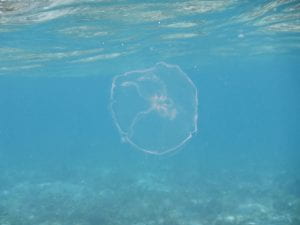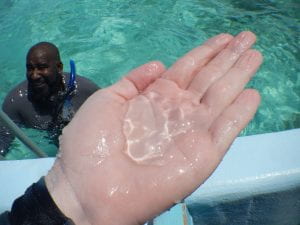May 25, 2019
Today was a big day for Scyphozoa and Ctenophores, otherwise known as true jellyfish and comb jellies respectively. When we unloaded at one of our experiment locations, we had to quickly get back into the boat when we realized Moon Jellies (Aurelia aurita) were everywhere (they can deliver a painful sting), but that doesn’t mean I didn’t take a picture first.
There were also a lot of comb jellies (unknown species). These jellies look similar to jellyfish but are actually from a completely different phylum and use sticky cells called colloblasts to catch prey rather than stinging cells like jellyfish. This is why Amanda was able to safely hold one in her hand.
Eventually, our marine safety officer Herbie found a reef that wasn’t infested with jellyfish. While he was checking the area, he said he saw lots of squid and lionfish. I didn’t end up finding any squid myself, but I did get to watch Herbie spear one of the lionfish – they’re invasive to the Caribbean and eat a lot of important herbivorous fish populations.
Later, we went to the forereef, which was much deeper than the patch reefs inside the atoll. I got to see some living elkhorn coral (Acropora palmata), a nurse shark, several southern sting rays, and a very linear group of small squid.



